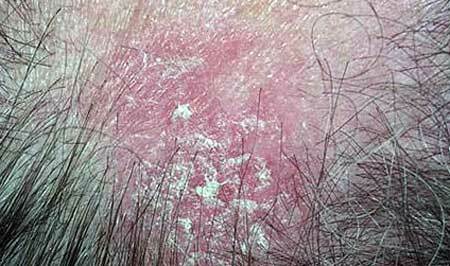Couperose is a pink droplet, a name given to the skin pathology by the French surgeon Guy de Scholiak, who first described the disease in the XIV century. With the light hand of the English dermatologist Thomas Bateman in the early 18th century, the disease received a new name - rosacea( rosacea, erythema episodic, pink acne), preserved to this day.
What is it? Rosacea is a disease characterized by erythematous and papular-pustular lesions of the facial skin. It belongs to the class of chronic dermatoses( see photo).
Genesis is caused by angioneurosis, characterized by vascular disorders in the area of afferent innervation of mixed cranial nerves( trigeminal nerve), caused by a variety of causative factors:
- congenital vascular pathologies( angiopathy);
- violation of neurovegetative maintenance and hormonal failure;
- with psychoemotional disorders;
- with focal secondary( focal) infections;
- due to violations of the functions of the gastrointestinal system.
Any of these factors can cause violations in the regulatory function of blood circulation in parts of the peripheral vascular bed - small arteries, arterioles, capillary and venous vessels. This causes a disturbance in the cellular nutrition of the dermis and epidermis, dystrophic processes in collagen fibers and the hair and hair apparatus, with the manifestation of the body's response in the form of inflammatory processes and the manifestation of rosacea of the skin.
A provoking factor can serve as a stimulant - alcoholic beverages and hot food, the effects of sunlight, heat or cold.
Contents
- 1 Symptoms of Rosacea on face, photo
- 2 Special forms of "pink droplet"( rosacea)
- 3 Diagnostic examination
- 4 Treatment of rosacea on face
- 4.1 Recommendations for a diet for rosacea
Rosacea on face, photos
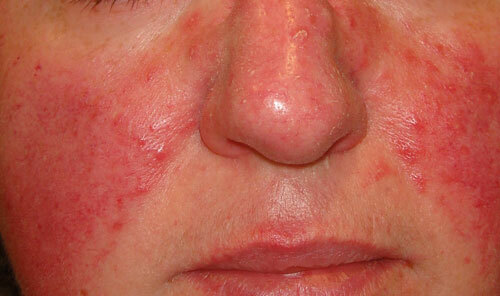
Rosacea on face photo
Signs andthe symptoms of rosacea are very diverse. The classical development of the disease is due to several successive stages.
1) The initial stage of is characterized by the formation of periodic redness on the face in the cheeks, nose, middle of the forehead and décolleté.Any stimulant can trigger them. The development of the disease leads to frequent attacks of redness, manifested by characteristic areas of persistent bright red foci, gradually acquiring a bluish tinge.
This process is caused by a violation of the integrity of the superficial subcutaneous veins, appearing on the surface of the skin through the transmission of red and purple spider veins( vascular sprockets).On the face there is a puffiness and a burning sensation, the skin starts to be shelled.
2) In the second stage of , the process of papulo-pustular lesion of the face begins. On the hyperemic surface there are nodular formations( papules), pustules( pustules), group localization of acne. Their disappearance does not cause tissue scarring, leaves behind, only an inconspicuous trace.
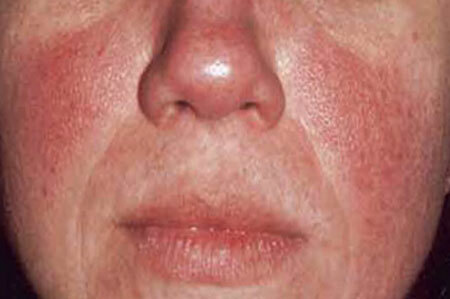
Clinical signs, photo 3
Puffiness in the upper zone of nose bridge and forehead area is noted. The sun's rays cause the formation of black closed comedones. Symptoms of irritation in the form of burning and tingling are weakened at this stage. And pustular pustules rapidly "scatter" throughout the face, breasts, sometimes spread to the back. Very severe itching symptoms accompany the localization of abscesses in the head.
3) The third stage of the is the most extensive, the disease progresses. It begins thickening on separate skin areas of the face and forehead, covers the surface of the nose and earlobes of the auricles. The skin becomes covered with tubercles, it becomes similar to the structure of the orange peel. Frequent complications in the form of rhinophyma are noted only in men, manifesting as a pineal extension of the nose. It increases, is covered with a fine vascular net, acquires a cyanotic color.
The development of the process leads to the formation of deep furrows on the surface of the nose, dividing it into separate hummocky parts. The eyelids and chin undergo changes and cutaneous thickening, the forehead becomes pillow-shaped, the earlobes look like a cauliflower. Women's skin is not subject to such changes, this is due to the possible protective effect of estrogens.
Very often, with rosacea pathology, the eyes are affected. Sometimes even before dermal manifestations. Characteristic is the development of blepharitis, manifested by peeling of hyperemic skin on the eyelids. Crusts appear in the corners of the eyes, the processes of acute conjunctivitis develop. Heavy processes can cause blindness.
Special forms of "pink droplet"( rosacea)
The clinical characteristics of rosacea are caused by various forms of its manifestation, which plays an important role in the proper selection of its medication, taking into account the factor of provocative influence.
- The shape of the conglobate pathology is characterized by the development in the subcutaneous fat layer of huge proliferation of conglobate globular acne. The development of this process is due to the treatment with iodine preparations and sedative preparations containing potassium bromide.
- The steroid form is a consequence of prolonged use of local hormonal drugs with the inclusion of fluoride. Steroid rosacea on the face of treatment is very hard to treat.
- Rosacea is lightning fast. It is manifested mainly in women on the background of neuropsychiatric disorders, pregnancy and menopause. Represents a complicated variation of conglobate rosacea. Development is sudden and rapidly progressive. Globular acne subcutaneous growth greatly disfigures the face. Low effective treatment provokes development of depression and neuroses in women.
- Rosacea edematous( lymphoedema).Rare pathology. It is manifested with a strong purple puffiness throughout the face. Pressing on the edema does not leave a hole after itself because the swelling is not caused by the accumulation of fluid, but by the strong growth of the subcutaneous adipose tissue. The general health of the patient is not violated, only the disfigured form of the face is strongly pronounced.
Diagnostic examination
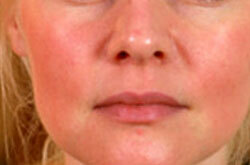 To confidently diagnose a disease, it is usually enough to examine the patient by a dermatologist. But for the selection of effective treatment requires additional examination. In complicated processes, with the formation of pustules and purulent vesicles,
To confidently diagnose a disease, it is usually enough to examine the patient by a dermatologist. But for the selection of effective treatment requires additional examination. In complicated processes, with the formation of pustules and purulent vesicles,
- is assigned to the study of bacteriological culture for the detection of cutaneous microflora;
- analysis of scrapings of the dermis, to determine the possible causative agent;
- general examination of the body, to identify provocative foci that promote the development of pink acne.
At the initial stage of development, the disease is well amenable to therapy, but in neglected periods, this will take time and a special, individual approach to the selection of treatment.
Treatment of rosacea on the face
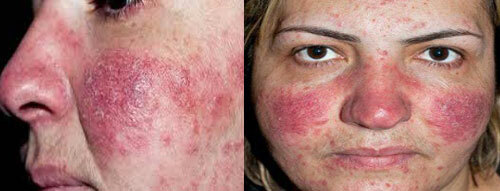
Methods of treating rosacea on the face are so diverse, how diverse are the causes that cause and aggravate the disease. The appointment of certain drugs is aimed mainly at reducing the development of rosacea on the face, the use of other drugs should eliminate background nervous and gastric pathologies.
- Irreversible, in the treatment of this disease, antibiotics of the class of polyketides( tetracyclines) - preparations of tetracycline hydrochloride, Doxycycline or Minocycline.
- Metronidazole and its analogues are effective, which have an antibacterial property and a high property to restore the mucous layer of the digestive system.
- As a topical treatment, hormonal creams, liquid suspensions, gels, various regenerating creams and ointments are used - Skinoren, Metrogil, Rosamet, Rosex. Eliminate the inflammatory processes, reduce the process of pustular rash, contribute to the smoothing of the skin.
- With the expressed process of vascular examination, vitamin preparations of Ascorutin are prescribed, which help to strengthen the vascular walls.
- The manifestation of severe inflammation and itchy symptomatology in the case of roceae, preparations "Suprostin", "Tavegil" or "Fenkorol", which have antiallergic effect, can soothe the skin. Homeopathic remedies in the form of motherwort, valerian or sage are used to bring the nervous disorders back to normal.
Physiotherapeutic methods of treatment of rosacea with laser, high-frequency light, cryotherapy and carbon dioxide( dry ice) are widely used. Such techniques effectively contribute to the elimination of small and large vascular neoplasms, control inflammatory reactions, selectively denature the affected vessels, and stimulate the regenerative tissue processes.
Recommendations for a diet with rosacea
But, without correcting the diet for rosacea, it is sometimes not possible to stop the progressing process. Food should be regular and divided, that is, taken often, but in small portions.
All stimulant ingredients - spicy, salted, smoked and canned food - should be removed from the diet. Refuse sweets and some fruits - pears, grapes and citrus fruits.
Abstain from alcohol, strong hot tea and coffee. In the diet should not include fatty meat and fish with heat treatment( with steam) with the addition of vegetable or butter, boiled potatoes and eggs, greens, vegetables and fruits( except prohibited), bezdozhzhevoy stale bread or crackers, cereals and lactic products.
In severe cases, a doctor can recommend a diet with curative fasting. This should be discussed individually.


